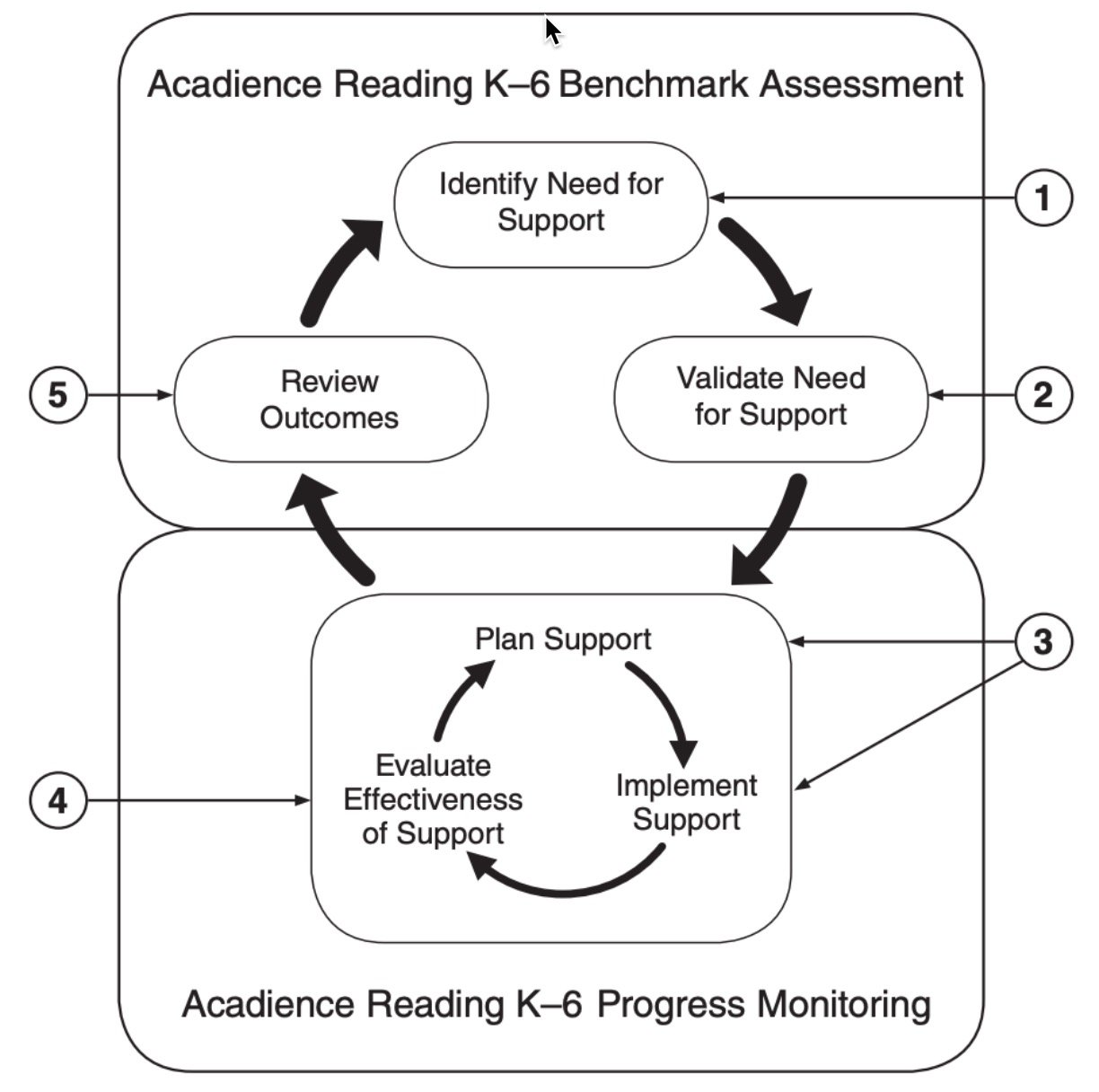Acadience Reading K-6 and the Outcomes-Driven Model
Acadience Reading and RtI: The Outcomes-Driven Model
The Acadience Reading measures were developed to provide teachers with information they need to make decisions about instruction. The authors of Acadience Reading advocate a data-based decision-making model referred to as the Outcomes-Driven Model, because the data are used to make decisions to improve student outcomes by matching the amount and type of instructional support with the needs of the individual students.
The Outcomes-Driven Model

These steps repeat each semester as a student progresses through the grades. At the beginning of the semester, the first step is to identify students who may need additional support. At the end of the semester, the final step is to review outcomes, which also facilitates identifying students who need additional support for the next semester. In this manner, educators can ensure that students who are on track to become proficient readers continue to make adequate progress, and that those students who are not on track receive the support they need to become proficient readers.
Step 1: Identify need for support early. This process occurs during benchmark assessment, and is also referred to as universal screening. The purpose is to identify those students who may need additional instructional support to achieve benchmark goals. The benchmark assessment also provides information regarding the performance of all students in the school with respect to benchmark goals. All students within a school or grade are tested on Acadience Reading three times per year on grade-level material. The testing occurs at the beginning, middle, and end of the school year.
Step 2: Validate need for support. The purpose of this step is to be reasonably confident that the student needs or does not need additional instructional support. Before making individual student decisions, it is important to consider additional information beyond the initial data obtained during benchmark testing. Teachers can always use additional assessment information and knowledge about a student to validate a score before making decisions about instructional support. If there is a discrepancy in the student’s performance relative to other information available about the student, or if there is a question about the accuracy of a score, the score can be validated by retesting the student using alternate forms of the Acadience Reading measures or additional diagnostic assessments as necessary.
Step 3: Plan and implement support. In general, for students who are meeting the benchmark goals, a good, research-based core classroom curriculum should meet their instructional needs, and they will continue to receive benchmark assessment three times per year to ensure they remain on track. Students who are identified as needing support are likely to require additional instruction or intervention in the skill areas where they are having difficulties.
Step 4: Evaluate and modify support as needed. Students who are receiving additional support should be progress monitored more frequently to ensure that the instructional support being provided is helping them get back on track. Students should be monitored on the measures that test the skill areas where they are having difficulties and receiving additional instructional support. Monitoring may occur once per month, once every two weeks, or as often as once per week. In general, students who need the most intensive instruction are progress monitored most frequently.
Step 5: Review outcomes. By looking at the benchmark assessment data for all students, schools can ensure that their instructional supports—both core curriculum and additional interventions—are working for all students. If a school identifies areas of instructional support that are not working as desired, the school can use the data to help make decisions on how to improve.
The use of Acadience Reading within the Outcomes-Driven Model is consistent with the most recent reauthorization of the Individuals with Disabilities Education Improvement Act (IDEA), which allows the use of a Response-to-Intervention (RtI) approach to identify children with learning disabilities. In an RtI approach to identification, early intervention is provided to students who are at risk for the development of learning difficulties. Data are gathered to determine which students are responsive to the intervention provided and which students are in need of more intensive support (Fuchs & Fuchs, 2006). The Outcomes-Driven Model described in the Figure above is based on foundational work with a problem-solving model (see Deno, 1989; Shinn, 1995; Tilly, 2008) and the initial application of the problem-solving model to early literacy skills (Kaminski & Good, 1998). The general questions addressed by a problem-solving model include: What is the problem? Why is it happening? What should be done about it? Did it work? (Tilly, 2008). The Outcomes-Driven Model was developed to address these questions, but within a prevention-oriented framework designed to preempt early reading difficulty and ensure step-by-step progress toward outcomes that will result in established, adequate reading achievement.
For more information please see the Assessment Manual located on the
Acadience® Reading K–6 download page.
